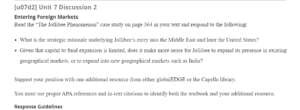Global Expansion
The Jollibee Phenomenon
What is the strategic rationale underlying Jollibee’s entry into the Middle East and later the United States?
Most global fast-food chains standardize their products so that the quality is consistent in all of their markets (Hitt et al., 2016). For instance, a company like McDonald’s sells the same consistent food options in its global markets. The company does not pay attention to the unique needs of each of its markets. Jollibee identified this characteristic as a weakness of McDonald’s. Therefore, Jollibee created a strategic rationale for product differentiation depending on the global market that the company ventures into. This strategy involves changing certain aspects of the foods on the menu to meet the needs of each local market (Hill & Hult, 2019). This company started this strategy in the Philippines and maintained it as it continued to expand into international markets. This strategy has been effective so far in making the company unique and helping it attract its target demographics in areas that seem saturated by similar companies, such as the United States market. Jollibee’s expansion into the Middle East and the U.S. have been successful because of the company’s differentiated products that attract target customers in a saturated market.
Given that capital to fund expansion is limited, does it make more sense for Jollibee to expand its presence in existing geographical markets, or to expand into new geographical markets such as India?
Given that the capital to fund expansion is limited, it would be advisable for Jollibee to expand into already existing markets. This business does well in markets that fast-food companies have already explored. In such markets, the customers are already used to the similar products that are provided by the businesses in the regions. Jollibee would be successful by introducing new flavors that will attract customers from other companies.
References
Hill, C., & Hult, T., (2019). Global Business Today Asia-Pacific Perspective. McGraw-Hill Education.
Hitt, M. A., Li, D., & Xu, K. (2016). International strategy: From local to global and beyond. Journal of World Business, 51(1), 58-73.
ORDER A PLAGIARISM-FREE PAPER HERE
We’ll write everything from scratch
Question
[u07d2] Unit 7 Discussion 2
Entering Foreign Markets
Read the “The Jollibee Phenomenon” case study on page 364 in your text and respond to the following:

Global Expansion
- What is the strategic rationale underlying Jollibee’s entry into the Middle East and later the United States?
- Given that capital to fund expansion is limited, does it make more sense for Jollibee to expand its presence in existing geographical markets, or to expand into new geographical markets such as India?
Support your position with one additional resource from either global EDGE or the Capella library.
You must use proper APA references and in-text citations to identify both the textbook and your additional resource.
Response Guidelines
Respond to two other learners.
Resources
UNDERGRADUATE DISCUSSION PARTICIPATION SCORING GUIDE
- Due Date: End of weekly . (Looking for DISTINGUISHED – set up your paper to hit each Topic)
Percentage of Course Grade: 30%.
| UNDERGRADUATE DISCUSSION PARTICIPATION GRADING RUBRIC | ||||
| Criteria | Non-performance | Basic | Proficient | Distinguished |
| Apply relevant course concepts, theories, or materials correctly. 33% |
Does not explain relevant course concepts, theories, or materials. | Explains relevant course concepts, theories, or materials. | Applies relevant course concepts, theories, or materials correctly. | Analyzes course concepts, theories, or materials correctly, using examples or supporting evidence. |
| Collaborate with fellow learners, relating the discussion to relevant course concepts. 33% |
Does not collaborate with fellow learners. | Collaborates with fellow learners without relating the discussion to the relevant course concepts. | Collaborates with fellow learners, relating the discussion to relevant course concepts. | Collaborates with fellow learners, relating the discussion to relevant course concepts and extending the dialogue. |
| Apply relevant professional, personal, or other real-world experiences. 34% |
Does not contribute professional, personal, or other real-world experiences. | Contributes professional, personal, or other real-world experiences, but contributions lack relevance. | Applies relevant professional, personal, or other real-world experiences. | Applies relevant professional, personal, or other real-world experiences to extend the dialogue. |

